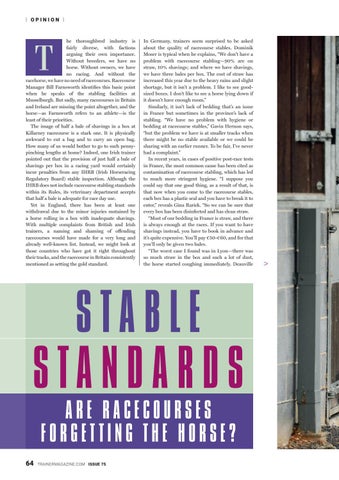| OPINION |
T
he thoroughbred industry is fairly diverse, with factions arguing their own importance. Without breeders, we have no horse. Without owners, we have no racing. And without the racehorse, we have no need of racecourses. Racecourse Manager Bill Farnsworth identifies this basic point when he speaks of the stabling facilities at Musselburgh. But sadly, many racecourses in Britain and Ireland are missing the point altogether, and the horse—as Farnsworth refers to an athlete—is the least of their priorities. The image of half a bale of shavings in a box at Killarney racecourse is a stark one. It is physically awkward to cut a bag and to carry an open bag. How many of us would bother to go to such pennypinching lengths at home? Indeed, one Irish trainer pointed out that the provision of just half a bale of shavings per box in a racing yard would certainly incur penalties from any IHRB (Irish Horseracing Regulatory Board) stable inspection. Although the IHRB does not include racecourse stabling standards within its Rules, its veterinary department accepts that half a bale is adequate for race day use. Yet in England, there has been at least one withdrawal due to the minor injuries sustained by a horse rolling in a box with inadequate shavings. With multiple complaints from British and Irish trainers, a naming and shaming of offending racecourses would have made for a very long and already well-known list. Instead, we might look at those countries who have got it right throughout their tracks, and the racecourse in Britain consistently mentioned as setting the gold standard.
In Germany, trainers seem surprised to be asked about the quality of racecourse stables. Dominik Moser is typical when he explains, “We don’t have a problem with racecourse stabling—90% are on straw, 10% shavings; and where we have shavings, we have three bales per box. The cost of straw has increased this year due to the heavy rains and slight shortage, but it isn’t a problem. I like to see goodsized boxes. I don’t like to see a horse lying down if it doesn’t have enough room.” Similarly, it isn’t lack of bedding that’s an issue in France but sometimes in the province’s lack of stabling. “We have no problem with hygiene or bedding at racecourse stables,” Gavin Hernon says, “but the problem we have is at smaller tracks when there might be no stable available or we could be sharing with an earlier runner. To be fair, I’ve never had a complaint.” In recent years, in cases of positive post-race tests in France, the most common cause has been cited as contamination of racecourse stabling, which has led to much more stringent hygiene. “I suppose you could say that one good thing, as a result of that, is that now when you come to the racecourse stables, each box has a plastic seal and you have to break it to enter,” reveals Gina Rarick. “So we can be sure that every box has been disinfected and has clean straw. “Most of our bedding in France is straw, and there is always enough at the races. If you want to have shavings instead, you have to book in advance and it’s quite expensive. You’ll pay €50-€60, and for that you’ll only be given two bales. “The worst case I found was in Lyon—there was so much straw in the box and such a lot of dust, the horse started coughing immediately. Deauville
ARE RACECOURSES FORGETTING THE HORSE? 64
TRAINERMAGAZINE.COM ISSUE 75
